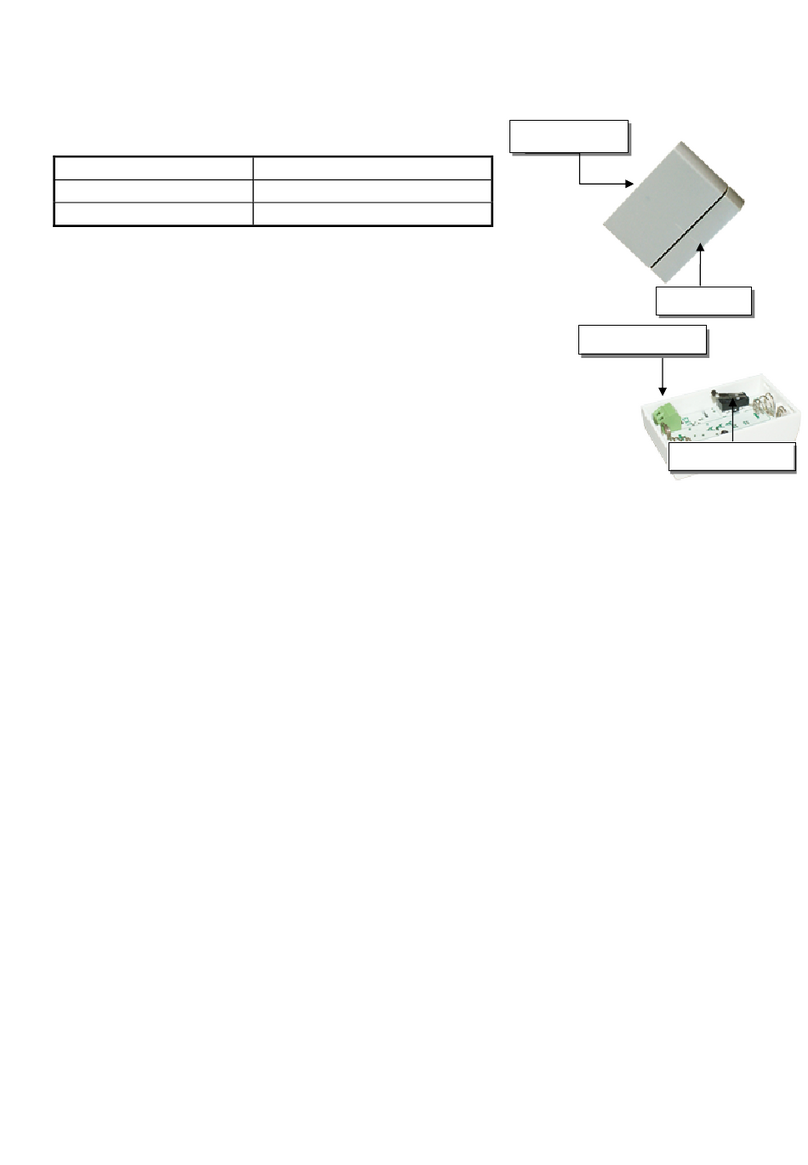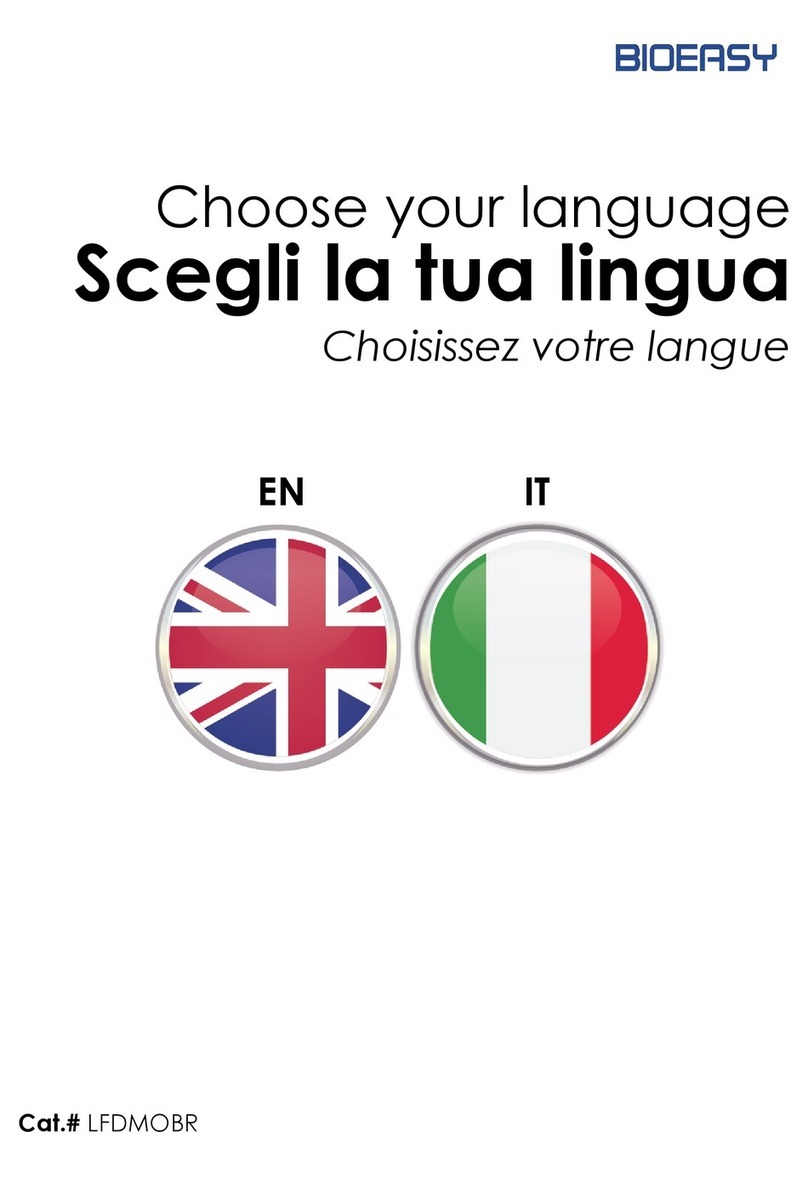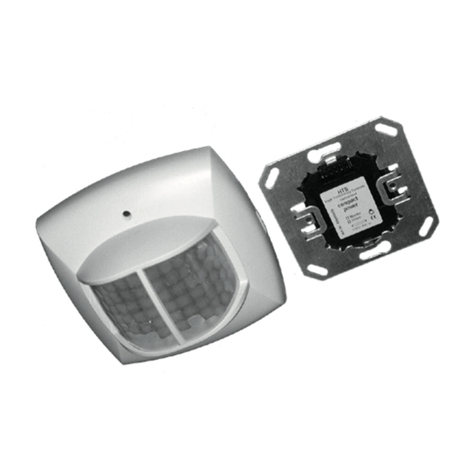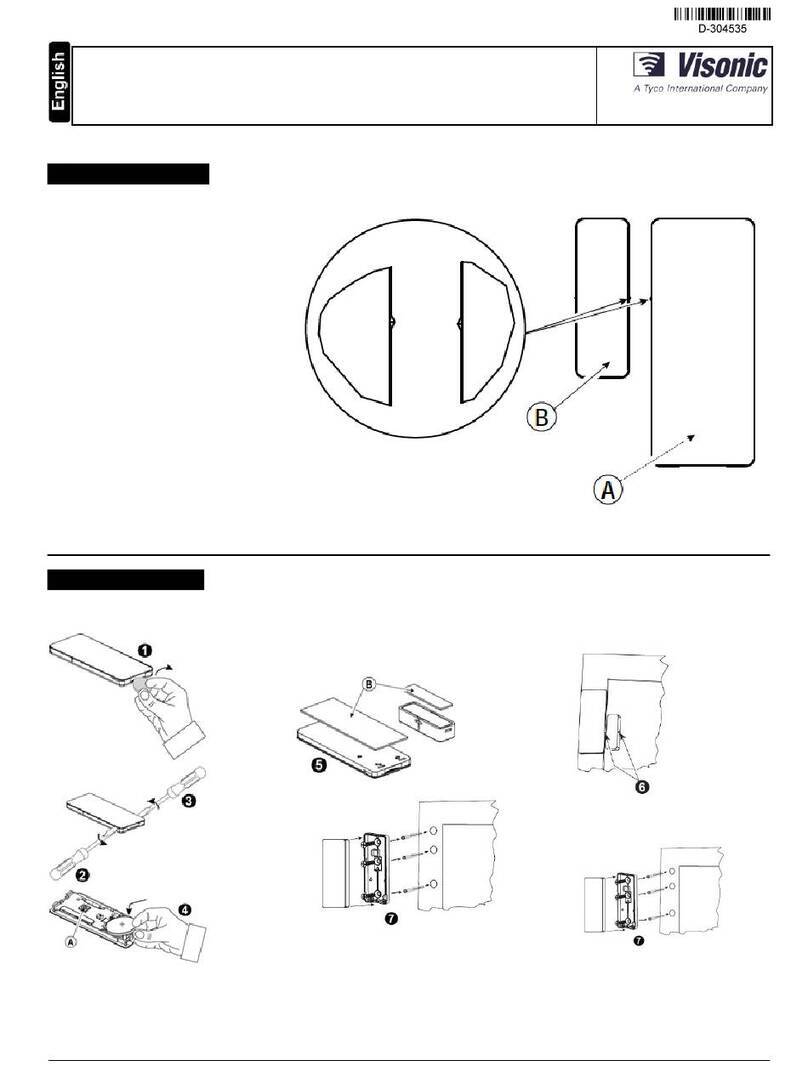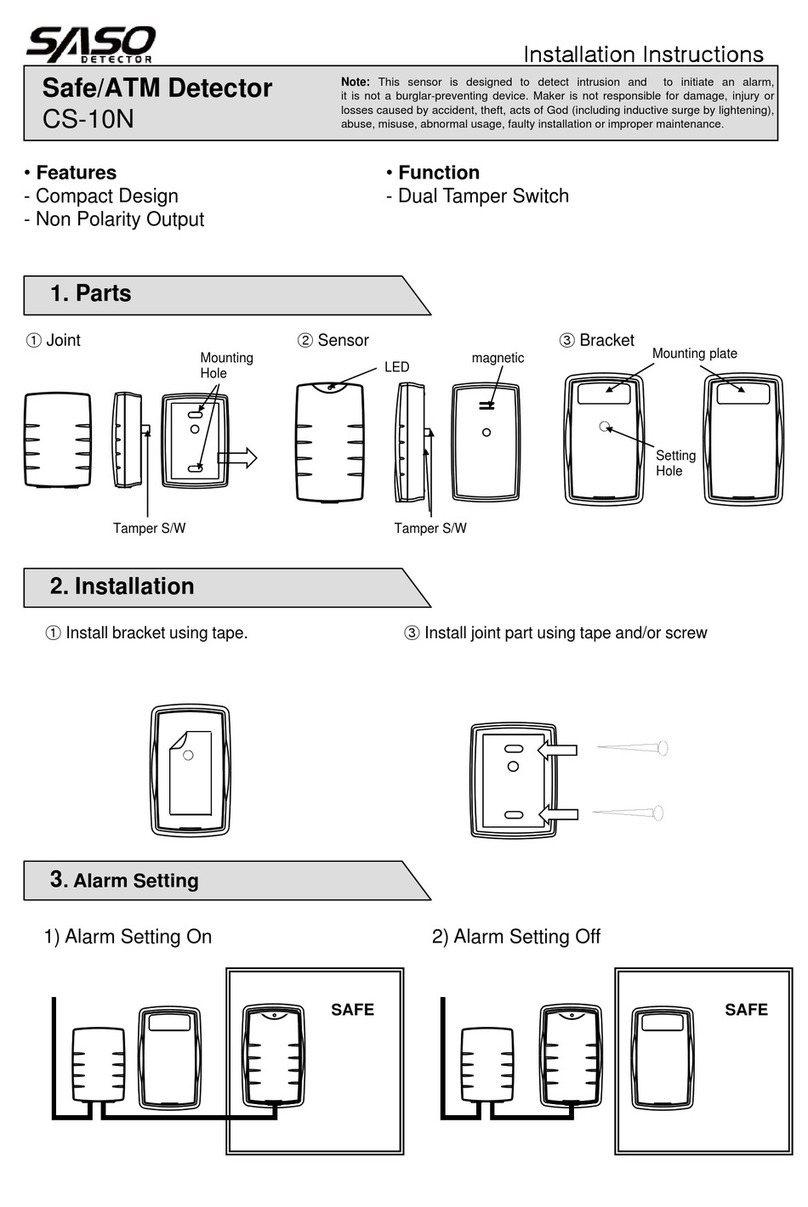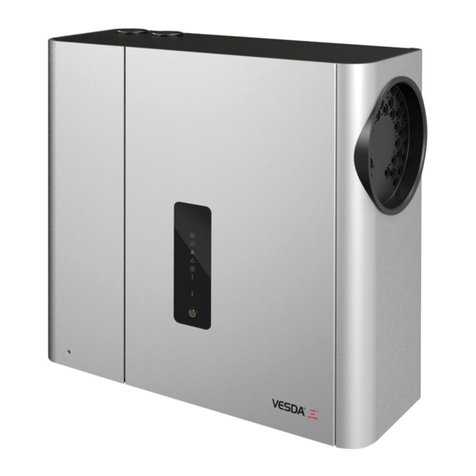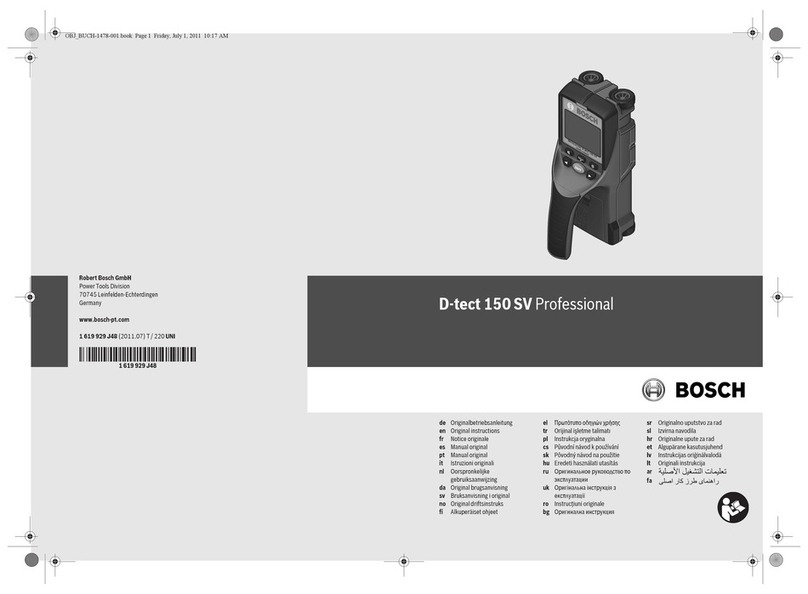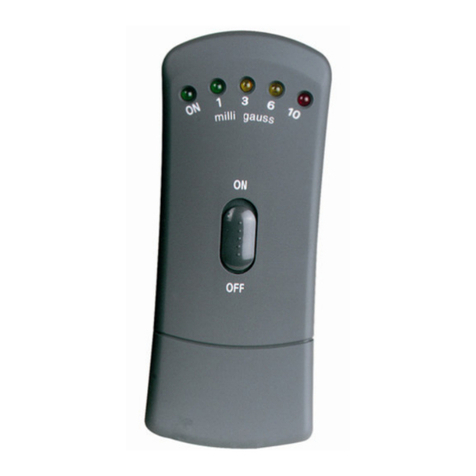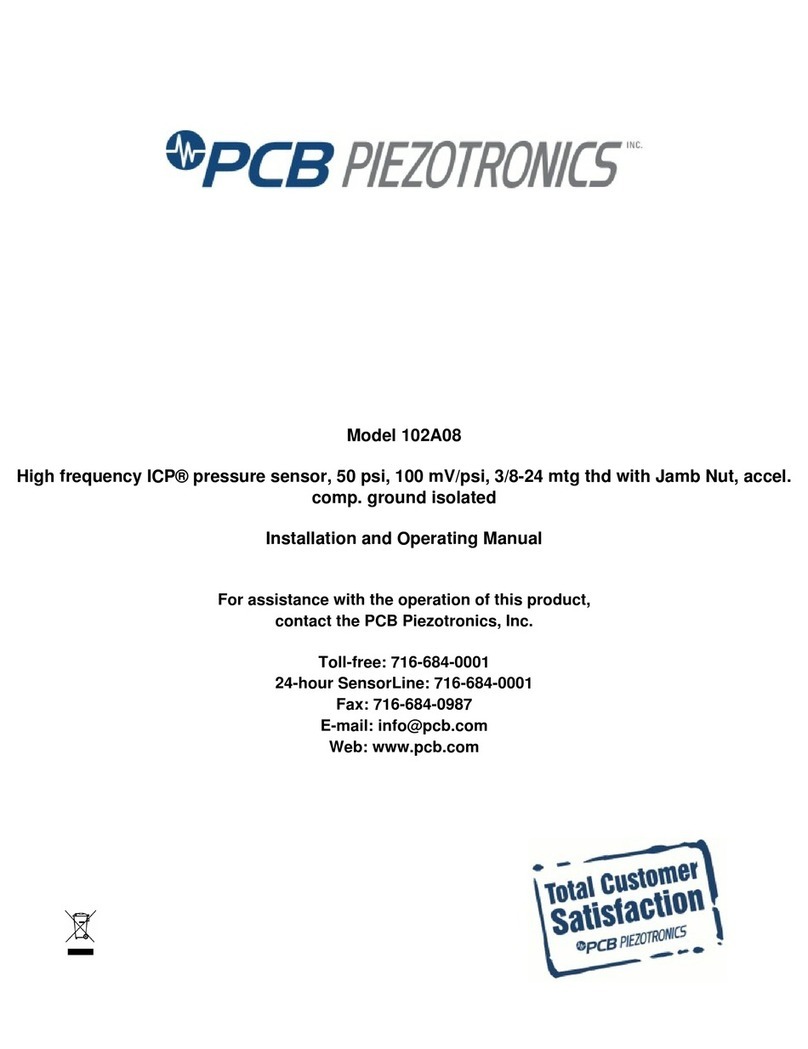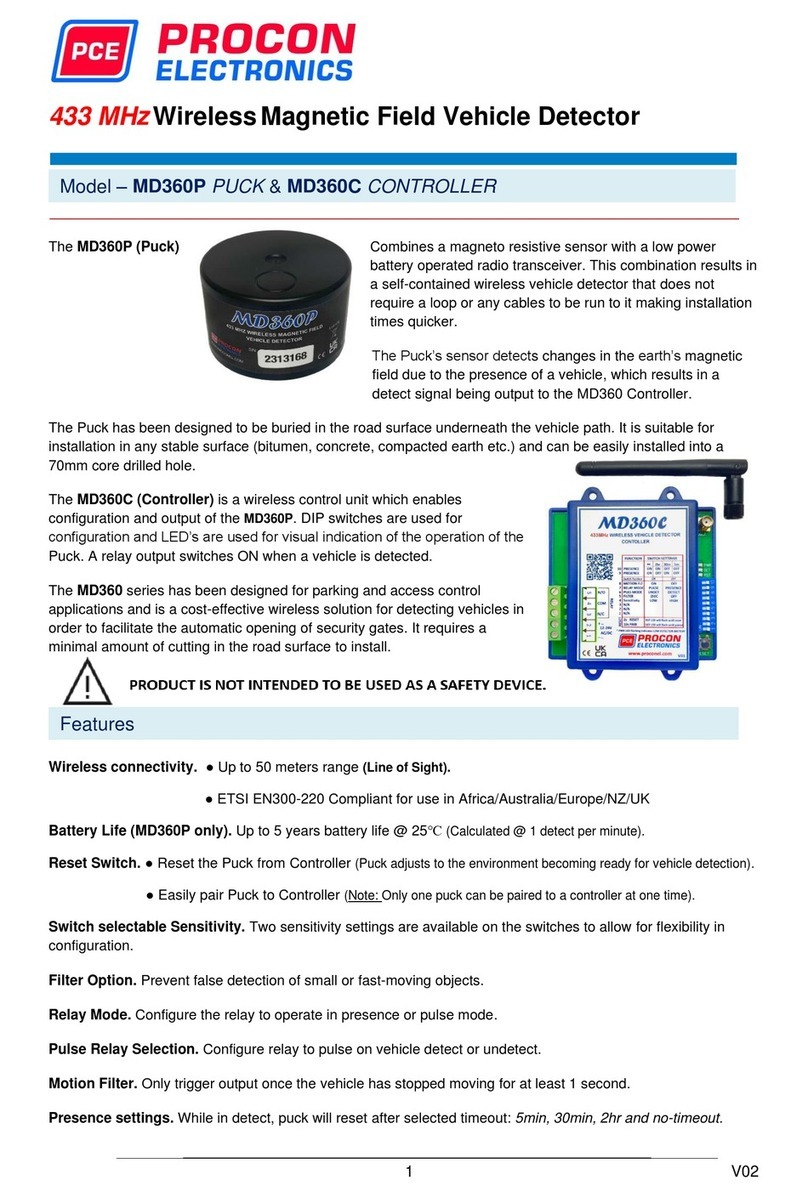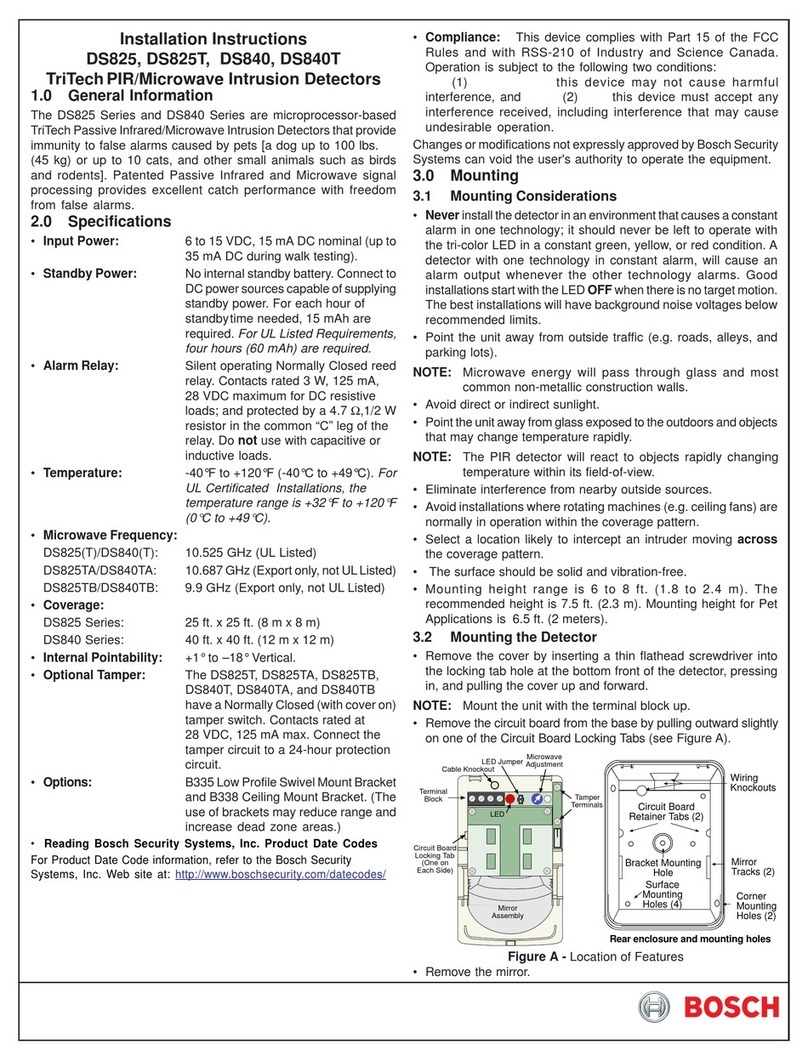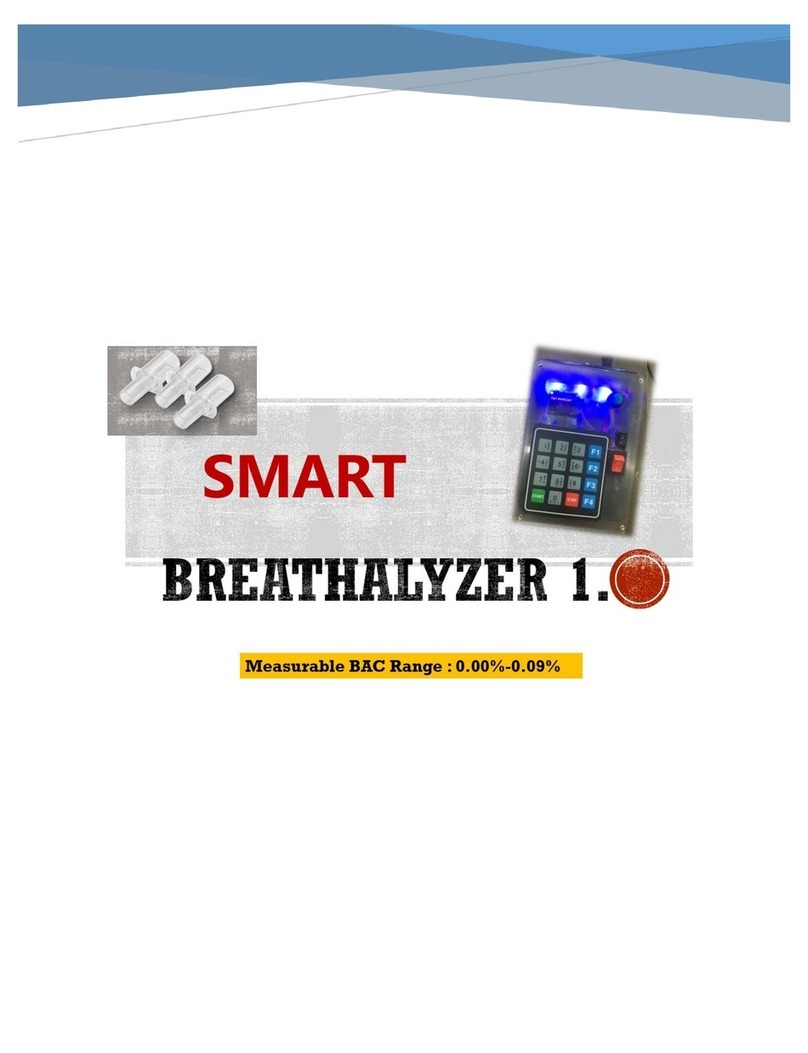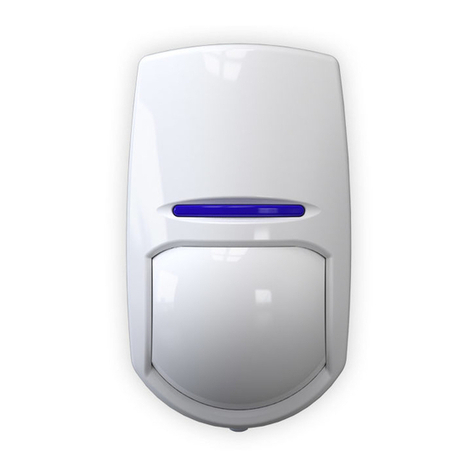Metrohm Vario-SW 947 Series User manual

947 Professional UV/VIS Detector Vario
2.947.00x0
Manual
8.0947.8001EN / 2020-06-30


Metrohm AG
CH-9100 Herisau
Switzerland
Phone +41 71 353 85 85
Fax +41 71 353 89 01
www.metrohm.com
947 Professional UV/VIS Detector
Vario
2.947.00x0
Manual
8.0947.8001EN / 2020-06-30

Technical Communication
Metrohm AG
CH-9100 Herisau
This documentation is protected by copyright. All rights reserved.
This documentation has been prepared with great care. However, errors
can never be entirely ruled out. Please send comments regarding possible
errors to the address above.

■■■■■■■■■■■■■■■■■■■■■■ Table of contents
947 Professional UV/VIS Detector Vario (2.947.00x0) ■■■■■■■■ III
Table of contents
1 Introduction 1
1.1 Instrument description ......................................................... 1
1.2 Product versions ................................................................... 1
1.3 Intended use ......................................................................... 2
1.4 About the documentation ................................................... 2
1.4.1 Symbols and conventions ........................................................ 2
1.5 Safety instructions ................................................................ 3
1.5.1 General notes on safety ........................................................... 3
1.5.2 Electrical safety ........................................................................ 3
1.5.3 Tubing and capillary connections ............................................. 5
1.5.4 Flammable solvents and chemicals ........................................... 5
1.5.5 Recycling and disposal ............................................................. 5
2 Overview of the instrument 6
2.1 Front ...................................................................................... 6
2.2 Rear ........................................................................................ 7
3 Installation 9
3.1 Setting up the instrument .................................................... 9
3.1.1 Packaging ................................................................................ 9
3.1.2 Checks .................................................................................... 9
3.1.3 Location .................................................................................. 9
3.2 Setup configurations ............................................................ 9
3.3 Base tray and bottle holder ............................................... 11
3.3.1 Basic information on base tray and bottle holder ................... 11
3.3.2 Mounting base tray and bottle holder (optional) .................... 11
3.4 Connecting the flow-through cell ..................................... 16
3.5 Installing the lamps ............................................................ 18
3.5.1 Installing the VIS lamp ........................................................... 20
3.5.2 Installing the UV lamp ........................................................... 23
3.6 Connecting the instrument ................................................ 28
3.6.1 Connecting the instrument to a computer ............................. 28
3.6.2 Connecting the instrument to the power grid ........................ 28
4 Start-up 30
4.1 Adjusting the lamp settings .............................................. 30
4.1.1 Operation with UV lamp and VIS lamp ................................... 31
4.1.2 Operation with UV lamp ........................................................ 34
4.1.3 Operation with VIS lamp ........................................................ 37

Table of contents ■■■■■■■■■■■■■■■■■■■■■■
IV ■■■■■■■■ 947 Professional UV/VIS Detector Vario (2.947.00x0)
4.2 Checking the intensity spectrum ...................................... 39
5 Operation 43
6 Operation and maintenance 44
6.1 Care ...................................................................................... 44
6.2 Maintenance by Metrohm Service .................................... 44
6.3 Door ..................................................................................... 45
6.4 Replacing the lamps ........................................................... 45
6.4.1 Replacing the VIS lamp .......................................................... 46
6.4.2 Replacing the UV lamp .......................................................... 48
6.5 Cleaning the flow-through cell .......................................... 51
7 Troubleshooting 57
7.1 Problems and their solutions ............................................. 57
8 Technical specifications 58
8.1 Reference conditions .......................................................... 58
8.2 UV/VIS detector .................................................................. 58
8.3 Lamps .................................................................................. 60
8.4 Ambient conditions ............................................................ 60
8.5 Dimensions .......................................................................... 60
8.6 Housing ............................................................................... 61
8.7 Controls ............................................................................... 61
8.8 Power connection ............................................................... 61
8.9 Interfaces ............................................................................. 61
9 Accessories 62
Index 63

■■■■■■■■■■■■■■■■■■■■■■ Table of figures
947 Professional UV/VIS Detector Vario (2.947.00x0) ■■■■■■■■ V
Table of figures
Figure 1 Type plate – Example ......................................................................... 1
Figure 2 Front – Overview ............................................................................... 6
Figure 3 Rear – Overview ................................................................................ 7
Figure 4 Setup configurations ....................................................................... 10
Figure 5 Removing the base tray ................................................................... 12
Figure 6 Mounting the base tray ................................................................... 13
Figure 7 Removing the bottle holder ............................................................. 14
Figure 8 Mounting the bottle holder ............................................................. 15
Figure 9 Connecting the capillaries ................................................................ 17
Figure 10 Lamp module – Overview ................................................................ 19
Figure 11 VIS lamp (6.2804.100) – Overview .................................................. 20
Figure 12 Removing the socket cap for the VIS lamp ....................................... 21
Figure 13 Inserting the VIS lamp ..................................................................... 21
Figure 14 Fastening the VIS lamp .................................................................... 22
Figure 15 Connecting the VIS lamp ................................................................. 22
Figure 16 UV lamp (6.2804.110) – Overview ................................................... 23
Figure 17 Removing the socket cap for the UV lamp ....................................... 24
Figure 18 Inserting the UV lamp ...................................................................... 25
Figure 19 Inserting the adjustment ring ........................................................... 25
Figure 20 Tightening the adjustment ring ........................................................ 26
Figure 21 Connecting the UV lamp ................................................................. 26
Figure 22 Setting the integration duration ....................................................... 32
Figure 23 Adjusting the UV lamp .................................................................... 33
Figure 24 Optimized intensity spectrum with UV lamp and VIS lamp ............... 34
Figure 25 Setting the integration duration ....................................................... 35
Figure 26 Adjusting the UV lamp .................................................................... 36
Figure 27 Optimized intensity spectrum with UV lamp .................................... 37
Figure 28 Optimized intensity spectrum with VIS lamp .................................... 39
Figure 29 Intensity spectrum OK ..................................................................... 40
Figure 30 Lamp intensity too high ................................................................... 41
Figure 31 Lamp intensity too low .................................................................... 41
Figure 32 Disconnecting the VIS lamp ............................................................. 46
Figure 33 Loosening the knurled screw ........................................................... 47
Figure 34 Removing the VIS lamp ................................................................... 47
Figure 35 Disconnecting the UV lamp ............................................................. 49
Figure 36 Loosening the adjustment ring ........................................................ 49
Figure 37 Removing the adjustment ring ......................................................... 50
Figure 38 Removing the UV lamp .................................................................... 50
Figure 39 Flow-through cell – parts ................................................................. 54
Figure 40 Inserting the flow-through cell ........................................................ 55
Figure 41 Screwing in the knurled screws ........................................................ 56


■■■■■■■■■■■■■■■■■■■■■■ 1 Introduction
947 Professional UV/VIS Detector Vario (2.947.00x0) ■■■■■■■■ 1
1 Introduction
1.1 Instrument description
The 947 Professional UV/VIS Detector Vario is an independent instru-
ment for the photometric determination of light-absorbing substances in
the UV/VIS range. It serves as UV/VIS detector within an ion chromatogra-
phy system.
The 947 Professional UV/VIS Detector Vario is operated with the
MagIC Net software. It is connected to a PC on which MagIC Net is
installed with a USB cable. The software detects the instrument automati-
cally and checks its functional readiness. MagIC Net controls and monitors
the instrument, evaluates the measured data and manages it in a data-
base.
Additional information on operating MagIC Net can be found in the docu-
ment "MagIC Net Tutorial" or in the software's online help.
1.2 Product versions
The 947 Professional UV/VIS Detector Vario is available in the following
versions:
Table 1 Product versions
Art. no. Designation Version feature: Detection
2.947.0010 Professional UV/VIS Detector Vario - SW 1 wavelength, variable
2.947.0020 Professional UV/VIS Detector Vario - MW 1-8 wavelengths, variable
The required numbers for the customer service can be found on the type
plate (see example):
Figure 1 Type plate – Example
1(01) = External article number 2(21) = Serial number
3(240) = Metrohm article number

1.3 Intended use ■■■■■■■■■■■■■■■■■■■■■■
2■■■■■■■■ 947 Professional UV/VIS Detector Vario (2.947.00x0)
NOTICE
Information on the accessories for the respective product version can
be obtained either on the Internet at http://www.metrohm.com or
from your regional Metrohm representative.
1.3 Intended use
The 947 Professional UV/VIS Detector Vario is used as an independent
detector with various analysis instruments of the Metrohm line of instru-
ments.
This instrument is suitable for processing chemicals and flammable sam-
ples. Therefore, the use of the 947 Professional UV/VIS Detector Vario
requires the user to have basic knowledge and experience in handling
toxic and caustic substances. Knowledge regarding the application of fire
prevention measures prescribed for laboratories is also mandatory.
1.4 About the documentation
CAUTION
Read through this documentation carefully before putting the instru-
ment into operation. The documentation contains information and
warnings which the user must follow in order to ensure safe operation
of the instrument.
1.4.1 Symbols and conventions
The following symbols and formatting may appear in this documentation:
Cross-reference to figure legend
The first number refers to the figure number, the sec-
ond to the instrument part in the figure.
Instruction step
Carry out these steps in the sequence shown.
Method Dialog text, parameter in the software
File ▶ New Menu or menu item
[Next] Button or key

■■■■■■■■■■■■■■■■■■■■■■ 1 Introduction
947 Professional UV/VIS Detector Vario (2.947.00x0) ■■■■■■■■ 3
WARNING
This symbol draws attention to a possible life-threat-
ening hazard or risk of injury.
WARNING
This symbol draws attention to a possible hazard due
to electrical current.
WARNING
This symbol draws attention to a possible hazard due
to heat or hot instrument parts.
WARNING
This symbol draws attention to a possible biological
hazard.
CAUTION
This symbol draws attention to possible damage to
instruments or instrument parts.
NOTE
This symbol highlights additional information and
tips.
1.5 Safety instructions
1.5.1 General notes on safety
WARNING
Operate this instrument only according to the information contained in
this documentation.
This instrument left the factory in a flawless state in terms of technical
safety. To maintain this state and ensure non-hazardous operation of the
instrument, the following instructions must be observed carefully.
1.5.2 Electrical safety
The electrical safety when working with the instrument is ensured as part
of the international standard IEC 61010.

1.5 Safety instructions ■■■■■■■■■■■■■■■■■■■■■■
4■■■■■■■■ 947 Professional UV/VIS Detector Vario (2.947.00x0)
WARNING
Only personnel qualified by Metrohm are authorized to carry out service
work on electronic components.
WARNING
Never open the housing of the instrument. The instrument could be
damaged by this. There is also a risk of serious injury if live components
are touched.
There are no parts inside the housing which can be serviced or replaced
by the user.
Supply voltage
WARNING
An incorrect supply voltage can damage the instrument.
Only operate this instrument with a supply voltage specified for it (see
rear panel of the instrument).
Protection against electrostatic charges
WARNING
Electronic components are sensitive to electrostatic charges and can be
destroyed by discharges.
Do not fail to pull the power cord out of the power socket before you
set up or disconnect electrical plug connections at the rear of the
instrument.

■■■■■■■■■■■■■■■■■■■■■■ 1 Introduction
947 Professional UV/VIS Detector Vario (2.947.00x0) ■■■■■■■■ 5
1.5.3 Tubing and capillary connections
CAUTION
Leaks in tubing and capillary connections are a safety risk. Tighten all
connections well by hand. Avoid applying excessive force to tubing con-
nections. Damaged tubing ends lead to leakage. Appropriate tools can
be used to loosen connections.
Check the connections regularly for leakage. If the instrument is used
mainly in unattended operation, then weekly inspections are manda-
tory.
1.5.4 Flammable solvents and chemicals
WARNING
All relevant safety measures are to be observed when working with
flammable solvents and chemicals.
■Set up the instrument in a well-ventilated location (e.g. fume cup-
board).
■Keep all sources of flame far from the workplace.
■Clean up spilled liquids and solids immediately.
■Follow the safety instructions of the chemical manufacturer.
1.5.5 Recycling and disposal
This product is covered by European Directive 2012/19/EU, WEEE – Waste
Electrical and Electronic Equipment.
The correct disposal of your old instrument will help to prevent negative
effects on the environment and public health.
More details about the disposal of your old instrument can be obtained
from your local authorities, from waste disposal companies or from your
local dealer.

2.1 Front ■■■■■■■■■■■■■■■■■■■■■■
6■■■■■■■■ 947 Professional UV/VIS Detector Vario (2.947.00x0)
2 Overview of the instrument
2.1 Front
Figure 2 Front – Overview
1Standby indicator 2Flow-through cell

■■■■■■■■■■■■■■■■■■■■■■ 2 Overview of the instrument
947 Professional UV/VIS Detector Vario (2.947.00x0) ■■■■■■■■ 7
2.2 Rear
Figure 3 Rear – Overview
1Type plate 2Vent
3UV connection socket
For connecting the cable of the UV lamp.
4VIS connection socket
For connecting the cable of the VIS lamp.
5UV lamp opening
When the instrument is delivered, the open-
ing with the socket cap for the UV lamp is
closed.
6VIS lamp opening
When the instrument is delivered, the open-
ing with the socket cap for the VIS lamp is
closed.
7Lamp cooling element 8PC connection socket
For connecting the USB cable to the PC.

2.2 Rear ■■■■■■■■■■■■■■■■■■■■■■
8■■■■■■■■ 947 Professional UV/VIS Detector Vario (2.947.00x0)
9LAN connection socket
For connecting the LAN cable.
The LAN connection socket is closed with a
blind cover. The connector is not functional.
10 Analog connection socket
Output for analog signals.
11 Power socket
For connecting the power cord.
12 Power switch
For switching the instrument on and off.
I = On
O = Off

■■■■■■■■■■■■■■■■■■■■■■ 3 Installation
947 Professional UV/VIS Detector Vario (2.947.00x0) ■■■■■■■■ 9
3 Installation
3.1 Setting up the instrument
3.1.1 Packaging
The instrument is supplied in protective packaging together with the sepa-
rately packed accessories. Keep this packaging, as only this ensures safe
transportation of the instrument.
3.1.2 Checks
Immediately after receipt, check whether the shipment has arrived com-
plete and without damage by comparing it with the delivery note.
3.1.3 Location
The instrument has been developed for operation indoors. Do not use the
instrument in explosive environments.
Place the instrument in a location of the laboratory which is suitable for
operation and free of vibrations. Set up the instrument in such a way that
it is protected against corrosive atmosphere and contamination by chemi-
cals.
Protect the instrument against excessive temperature fluctuations and
direct sunlight.
The distance between the rear of the instrument and the wall must be
large enough to ensure air circulation on the cooling plate.
3.2 Setup configurations
CAUTION
Changes to the setup configuration or the location
Injuries to the feet caused by an instrument or parts of an instrument
falling down.
■Disconnect all connections before you move or lift the instrument.
The 947 Professional UV/VIS Detector Vario can be used as a detector
with all the instruments of the Metrohm IC family. For many applications
with photometric detection, a post-column derivatization with the 943
Professional Thermostat / Reactor Vario (2.943.0110) is required. To build

3.2 Setup configurations ■■■■■■■■■■■■■■■■■■■■■■
10 ■■■■■■■■ 947 Professional UV/VIS Detector Vario (2.947.00x0)
such a system, you will need a 947 Professional UV/VIS Detector Vario
and, for example, the following instruments:
■Any 940 Professional IC Vario or any 930 Compact IC Flex
■943 Professional Thermostat / Reactor Vario
■Optionally: 942 Extension Module Vario for sample preparation
■Optionally if the reagent is pumped with a high-pressure pump: Metro-
sep BP 1 Guard/2.0 backpressure column (6.1015.100)
An IC system with photometric detection and post-column derivatization
can be set up in various configurations.
Figure 4 Setup configurations
Notes on the setup configurations
If you want to set up the instruments in 2 stacks, we recommend you
order the following accessories to protect the instruments of the second
stack:
■Bottle holder (ProfIC) (6.2061.100)
■Base tray with sensor for Professional IC instruments (6.2061.110)
If you stack a 930 Compact IC Flex on a 947 Professional UV/VIS Detector
Vario, a 943 Professional Thermostat / Reactor Vario and/or a 942 Exten-
sion Module Vario, use the System Connector (6.2061.120) to accommo-
date the different base sizes.

■■■■■■■■■■■■■■■■■■■■■■ 3 Installation
947 Professional UV/VIS Detector Vario (2.947.00x0) ■■■■■■■■ 11
3.3 Base tray and bottle holder
3.3.1 Basic information on base tray and bottle holder
The base tray (6.2061.110) and bottle holder (6.2061.100) protect IC
instruments from dust, dirt and leaking fluids. The supply bottles for eluent
and auxiliary solutions can be positioned neatly on the bottle holder.
In a complex IC system, several different instruments may be used, such as
an analyzer, an extension module and a detector. These instruments can
be set up in one or more stacks. We recommend that a base tray and bot-
tle holder be mounted for each stack of IC instruments.
The bottle holder and base tray must be removed or set up if one of the
following instruments is to be mounted on or under a 940 Professional IC
Vario:
■One or more 942 Extension Module Vario
■Or another instrument with the same-sized footprint
3.3.2 Mounting base tray and bottle holder (optional)
The base tray and bottle holder come fully assembled on a new ion chro-
matograph. To install an Extension Module on the ion chromatograph,
remove the bottle holder and put it back on top of the topmost instru-
ment. To install an Extension Module under the ion chromatograph,
remove the base tray and set it under the lowest instrument.
3.3.2.1 Removing/mounting the base tray
Remove the base tray to install another instrument under the IC instru-
ment.
CAUTION
Do not pinch capillaries or leak sensor cables
Capillaries are fed through the guide ducts between the base tray and
the instrument. Pinches in the leak sensor cable or the capillaries may
lead to malfunctions.
■Unplug the leak sensor cable before you remove the base tray.
■Remove all the capillaries from the capillary ducts before you remove
the base tray.
Removing the base tray
Prerequisites
■The instrument is switched off.

3.3 Base tray and bottle holder ■■■■■■■■■■■■■■■■■■■■■■
12 ■■■■■■■■ 947 Professional UV/VIS Detector Vario (2.947.00x0)
■The bottle holder is cleared.
■All of the cable connections on the rear have been disconnected.
■The capillaries are removed from the guide ducts between the instru-
ment and the base tray.
■There are no loose parts in the instrument.
Accessories
■3 mm hex key (6.2621.100)
123
Figure 5 Removing the base tray
1Tilt the instrument sideways and lay it down flat.
2Loosen the 4 cylinder screws with the 3 mm hex key. Remove the cyl-
inder screws and their washers.
3Remove the base tray.
Always mount the base tray under the lowermost instrument of the stack.
Mounting the base tray
Prerequisites
■The instrument is switched off.
■The bottle holder is cleared.
■All of the cable connections on the rear have been disconnected.
■There are no loose parts in the instrument.
■The instrument is lying on its side, and the bottom surface is visible.
Accessories
■3 mm hex key (6.2621.100)
This manual suits for next models
3
Table of contents
Other Metrohm Security Sensor manuals
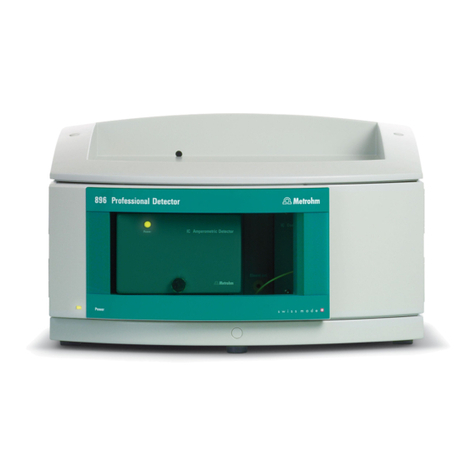
Metrohm
Metrohm 896 User manual
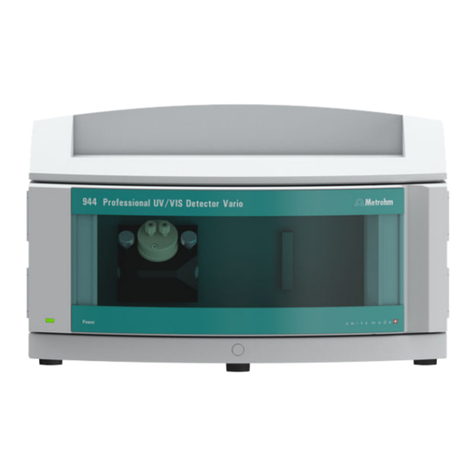
Metrohm
Metrohm 944 User manual
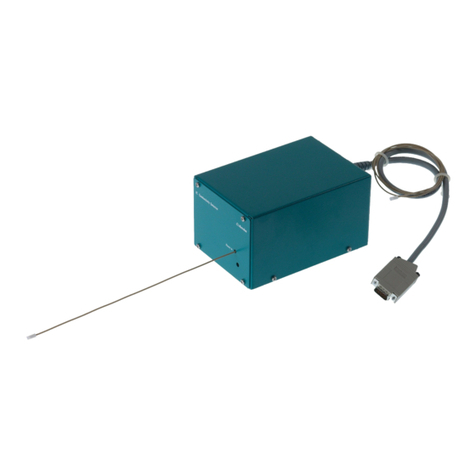
Metrohm
Metrohm IC Conductivity Detector User manual

Metrohm
Metrohm IC Conductivity Detector User manual
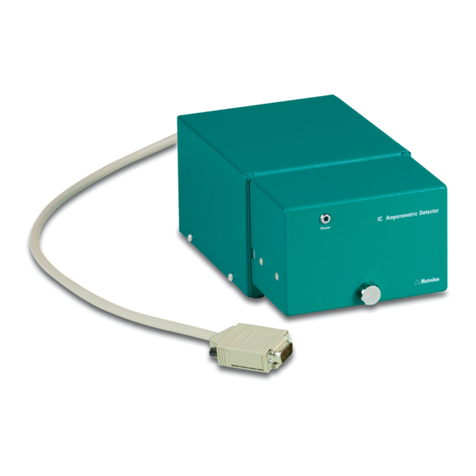
Metrohm
Metrohm IC Amperometric Detector User manual

Metrohm
Metrohm 887 User manual

Metrohm
Metrohm 945 Professional Detector Vario User manual
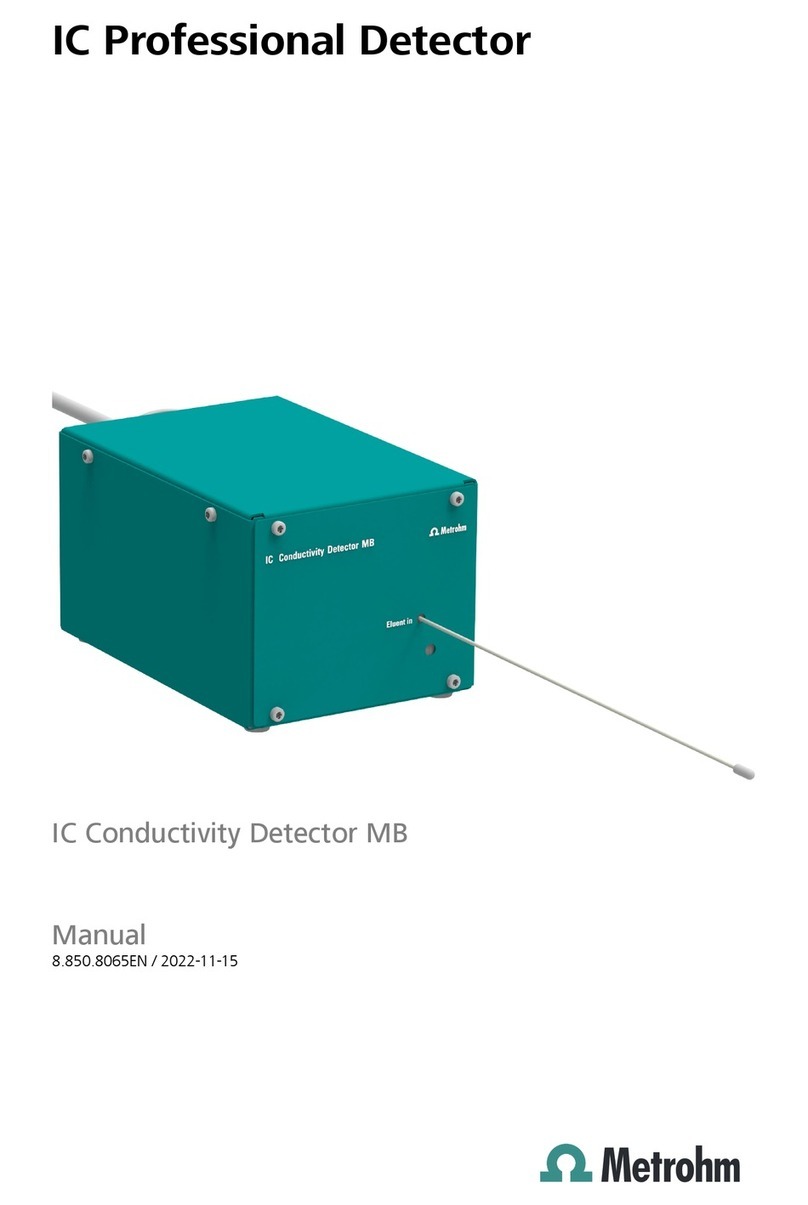
Metrohm
Metrohm MB User manual
